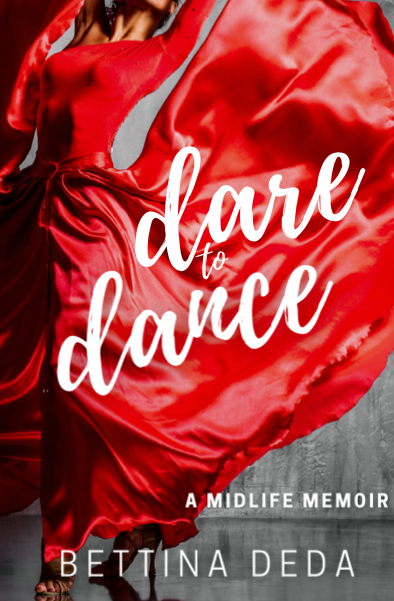Since I started ballroom dancing at the age of 52, a lot of people commented on my new passion. Men mostly encouraged me: ‘That’s great, keep dancing!’ Most women exclaimed with excitement in their eyes: ‘This is awesome! I always wanted to learn how to dance!’ When I replied that it is as easy as calling the dance school and arranging a first lesson to check it out – and a lot of schools offer complimentary first lessons – I heard all sorts of excuses why it’s not the right time now. Some day, maybe. And, at the same time, I knew that this some day would never come for most.
I am so grateful that I had the courage to open that studio door for the first time because I quickly found that dancing is the one thing that brings most joy to my life. Therefore, I decided to share the benefits of ballroom dancing and what dancing means to me.
I love moving my body, listening to music and combining both to learn new steps or a new dance. It requires concentration and immersing myself into this task fully, in other words, mindfulness. Something I have been practising in my yoga classes for ten years and now encountered on the dance floor. As one of my yoga teachers, who is also a Salsa dancer, pointed out: Yoga and dancing have a lot in common. In 2017, it was my almost daily yoga practice and the community in the yoga studio that supported me through challenging times. In 2018, it was the dancing that guided me through the next phase in my transition to a new chapter in my life. One day, I read on the black board in the yoga studio: “Go where you find most joy.” And I knew deep in my heart that this place is the dance studio.
Dancing is a total body workout
As I experienced over time, dancing is also a great way to stay fit and healthy. Samba, ChaCha or Swing are fantastic workouts and left me more than once literally breathless. To succeed in dancing requires also increased body awareness and balance. Where is my body weight in relationship to my feet? Are the feet turned in or turned out? Do the hips move or not? What is the position of the upper body in Smooth and Rhythm dances? How does the head position change in Waltz, Tango, and Foxtrot depending on the lead of my partner? There are layers and layers of technique to master when I learn a new dance or more advanced figures in a dance I have been practising for a while. What I realised in my first two years of dance lessons is that I became more aware of how I walk and how I hold my posture in every-day life. The teachers used to joke: ‘You can tell who is dancer when you watch people walking in the street.’ More often than not, I find myself practising steps and correcting my posture in between the supermarket aisles or when I am out walking. Even in the car, at the traffic lights, I mentally repeat what I learned in my lessons. I often practice at home where I refrained from putting rugs on my timber floor in the living room because I am using it as a dance floor.
One evening in November 2019, I was sitting in the bus going home from a social night at the dance school when I literally had a light bulb moment about something else that I learned from dancing. As often after dancing, I felt so happy that it made me emotional and tears filled my eyes. While watching the illuminated streetscape from the upper deck of the B-Line bus, I saw it so clearly that everything I learned from my instructor in ballroom dancing was exactly how I wanted to feel in a relationship.

What Tango teaches us about relationships
I learned that despite the fact that one person leads and the other follows, dancing is a partnership, not a dictatorship. As the follower, I let my partner take the lead and hold my own frame at the same time. I love the beginning of the Ballroom dances (Waltz, Foxtrot, Tango, Viennese Waltz, Quickstep) when my instructor reaches out his left arm and invites me to come towards him. I take his left hand and connect the right side of my body with his right side, while leaning in his right hand that supports my back. Only then, I place my left hand lightly on his right arm. Which means, I am connected to him with my frame. In this closed dance position, I feel safe, supported, and respected. And I know that I can trust him one hundred percent when he leads me across the dance floor. I surrender and enjoy the moment.
One thing I discovered about myself is that I had mostly lived in my head, not in my heart. Most of my adult life, I had forgotten my feminine super power: my feminine energy, my intuition, and my ability to surrender to ‘being’ instead of ‘doing’. In ballroom dancing, it is the same. Dancing from the head prevents us from ‘feeling’ the music and expressing ourselves creatively. I am still struggling with this concept, especially when I learn new steps or layers of difficult technique. As a result, I make mistakes and get frustrated. I don’t know how often my instructor said: “Stop thinking. Relax, and dance from your heart.”
Dancing with a partner also teaches you a lot about respect. Respect for each other’s space. Both, leader and follower, have their own dance frame, which both partners respect. They dance together as a couple while being aware of each other’s space. Dancing is a great metaphor for every-day life and how I want to be treated in a relationship. It also made me aware how often in my marriage I did not set the frame how I wanted to be treated, aka boundaries, and paved the way for misunderstandings, resentment and conflict.
Why dancing is good for your brain
Apart from my personal experiences, there are obviously many medical benefits of dancing published across the Internet, such as improved brain health, memory, and cognitive skills. This is especially applicable in International Ballroom where all dances are choreographed routines. Because of my choice to start dancing International competitions, I had to learn three new dances from scratch: Quickstep, Jive, and Paso Doble. All of them challenging in their own right. The advantage is that as the follower I know which steps or figures are coming up, however, the challenge is to get the routine right on the spot during the competition. Especially in the speedy dances Quickstep, Samba, ChaCha or Jive, one mistake can throw you totally out of the game. The trick to mastery is repetition, over and over again, until the muscle memory is established. In other words, dancing keeps my brain working.
Additionally, dancing contributes significantly to better fitness levels. Although it may not look like it from the outside, dancing is a full body workout using muscles I didn’t know I had.
Why dancing makes us happy
The most important thing, however, is that dancing never fails to make me happy. Sometimes to a point where my eyes fill with tears. After my dance lessons, no matter how physically and mentally demanding they were, I usually feel content and satisfied that I have achieved something. I feel uplifted and ready to tackle whatever challenges come my way. Science confirms that the release of the feel-good hormone Serotonin after an intensive workout can simply translate into happiness. Serotonin is a vital hormone that regulates the cardiovascular and endocrine systems, appetite, sleep, memory, and mood.
And the good news is that this happiness high is not a one-off situation. It is not restricted to the training session or the time immediately afterwards. Research also found that the more people exercise, the more the hormone concentration in the brain grows. Which leads to a sustainable improvement in concentration, more satisfaction and more happiness. That’s why dancing is so addictive. The more I dance and learn, the more I want to go back to the dance floor to practise it. A virtuous circle!
What is the one thing that makes your heart sing?
Further resources
Check out Dancesportlife for all things ballroom dancing!
Subscribe to my newsletter!
This article is an excerpt from my memoir Dare to Dance. Subscribe to my newsletter to be notified when the book is available.







